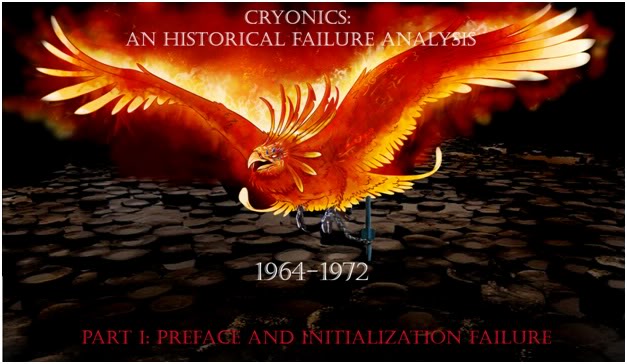
By Mike Darwin
FRAUDS & FAKIRS
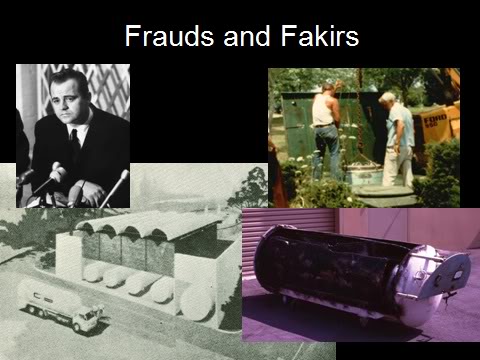
SLIDE 57
While this small corps of serious and honest people was hard at work trying to re-launch cryonics on a solid footing, the legacy of the first era of careless and irresponsible cryonics activity was maturing into what can only be described as a failure of truly catastrophic proportions.
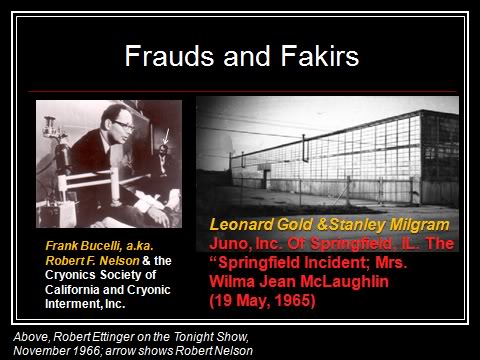
SLIDE 58
As early as 1965 Ettinger had appeared on national television and, in effect, endorsed cryonics operations which were either outright frauds, or were operated by an incompetent sociopath. No effort was made to verify any claims made, and all attempts to establish minimum standards for financial and technical conduct were rebuffed.
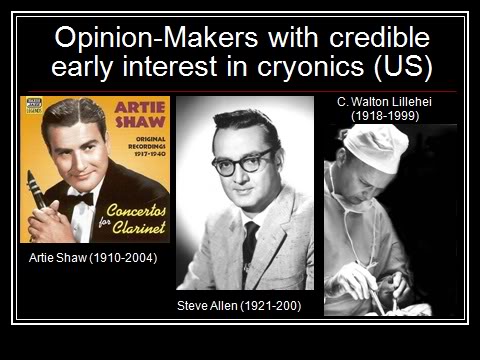
SLIDE 59
Wealthy and influential individuals with a deep personal interest in cryonics were put in touch with charlatans and con men that took their money and promptly disappeared. The men who appear on this slide were giants in their respective fields of music, television and cardiothoracic surgery. All were soon alienated by con artists such as Milgram and Gold
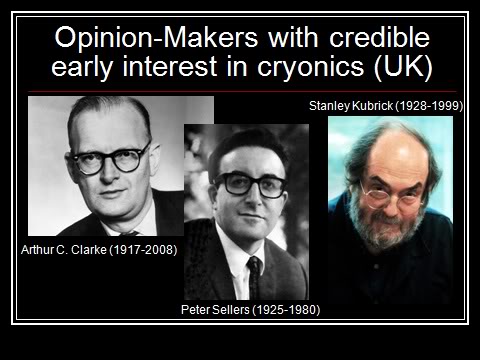
SLIDE 60
These internationally known and respected celebrities experienced similar mishandling, with similar results.
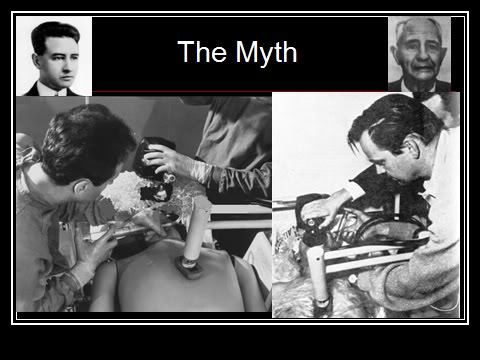
SLIDE 61
When the long awaited ‗freezing‘ of the first man took place on 12 January, 1967, the man in charge was Robert F. Nelson, aka Frank Bucelli, a Santa Monica TV repairman. Bucelli was much more than a TV repairman; he was a convicted felon with a long criminal record beginning in his youth; including violent offenses such as assault and battery as well as numerous charges, and several convictions for fraud and theft.
This background had been uncovered in 1966 by CSNY President Curtis Henderson, who had commissioned an investigative report on Nelson/Bucelli by the Pinkerton Agency, the most respected private detective service in the US at that time. This report was forwarded to Ettinger – but no action was taken. Nelson “froze the first man,” and in so doing he established the conditions under which cryonics would subsequently be practiced: lots of superficial media attention giving the appearance of openness and transparency, while at the same time operating in virtually complete secrecy from both the membership of his cryonics society (the Cryonics Society of California: CSC) as well as the press, the public and the regulatory authorities.
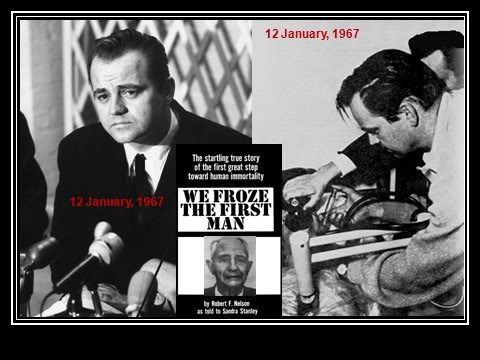
SLIDE 62
At the press conference CSC held following Dr. Bedford‘s freezing, the media were told that the first man had been frozen under “controlled conditions.” That a physician had been standing by with a mechanical CPR device (a Westinghouse Iron Heart) and that CPR had been initiated as soon ―as the patient‘s heart stopped,‖ followed by immediate packing in ice and cryoprotective perfusion and cooling to dry ice temperature (~ -77◦C).
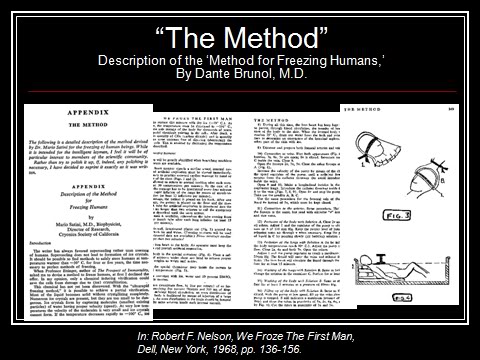
The Method: Description of the “Method for Freezing Humans,” By Dante Brunol, M.D., In: Robert F. Nelson, We Froze The First Man, Dell, New York, 1968, pp. 136-156.
SLIDE 63
Subsequently, an elaborate protocol that was purported to have been used called ‗The Method,‘ was circulated to cryonics society officials across the US, and shortly thereafter published in a supposedly factual book about Dr. Bedford‘s cryopreservation produced by Nelson in collaboration with a professional writer, Sandra Stanley (We Froze the First Man).
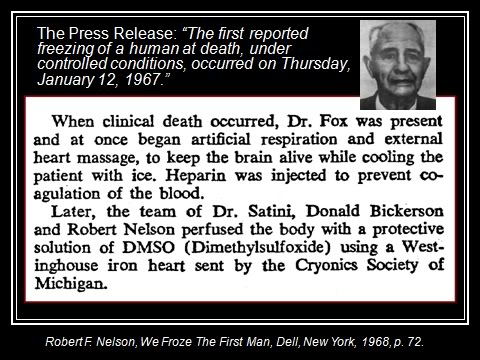
SLIDE 64
The Press Release: “The first reported freezing of a human at death, under controlled conditions, occurred on Thursday, January 12, 1967.” Robert F. Nelson, We Froze The First Man, Dell, New York, 1968, p. 72.
There has been a great deal of effort of late to portray Nelson as a victim of circumstance, as a well intentioned man who ―got in over his head and handled it badly.‖ Nothing could be further from the truth. As the press release quoted on this slide makes clear, Nelson lied, and he lied from the start. Dr. Bedford‘s cryopreservation in no way even remotely matched the brief description in the press release announcing his “freezing.”
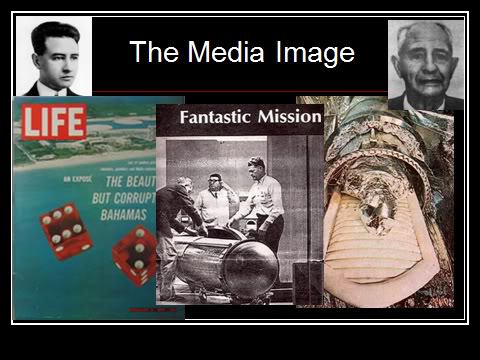
SLIDE 65
Nor was the reality of what had in fact happened in any way reflected in the myriad of subsequent media stories chronicling Dr. Bedford‘s cryopreservation. The media reported what they were told, principally that Dr. Bedford had received immediate post cardiac arrest cardiopulmonary support, cryoprotective perfusion with a DMSO-containing perfusate, and controlled cooling to dry ice temperature (~ -77◦C).

SLIDE 66
This slide graphically documents what the cryonics community and the world were told had been done for Dr. Bedford. The Amtec roller pump pictured here is the very model that is said to have been used in ‗the method‘ employed to cryoprotect and freeze Dr. Bedford. This newspaper article detailing his cryoprotective perfusion is the very article that caused me to become involved in cryonics in 1968.
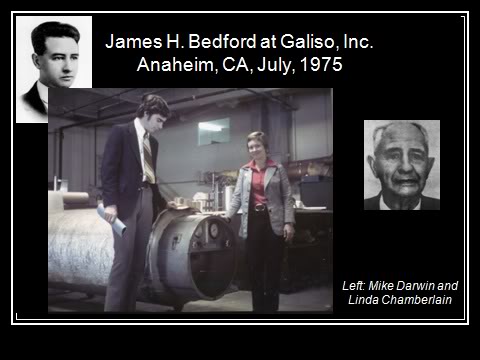
SLIDE 67
It wasn‘t until the mid-1970s that I began to piece together a very different story of what had happened to Dr. Bedford on that January night in 1967. A picture began to emerge of negligence fused with gross incompetence. When Dr. Bedford was pronounced legally dead, Nelson was nowhere to be found. There was no answering service, no list of numbers where he might be reached, and no equipment or supplies assembled, tested and at the ready.
It was, in fact, hours before Nelson could be located. There was no oxygen to power the heart lung resuscitator. The Amtec pump was owned by CSNY, not CSC, and there was in fact no pump, no perfusion and not even a cooperating mortuary.
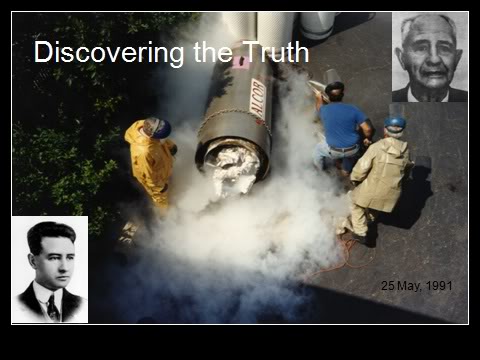
SLIDE 68
On 25 May, 1991, I at last had the opportunity to see for myself what Nelson and his cohorts had done to Dr. Bedford. On that sunny spring day we removed Dr. Bedford from his inefficient horizontal dewar to place him in an upright, “Bigfoot,” multi-patient storage vessel.
With careful preparation, this allowed us to examine Dr. Bedford externally, document his condition and take some (peripheral) tissue samples. We placed him in a large, foam insulated, open-topped tank of liquid nitrogen. This allowed us to examine him and evaluate his condition while keeping him continuously submerged in liquid nitrogen, thus precluding any danger of warming him.
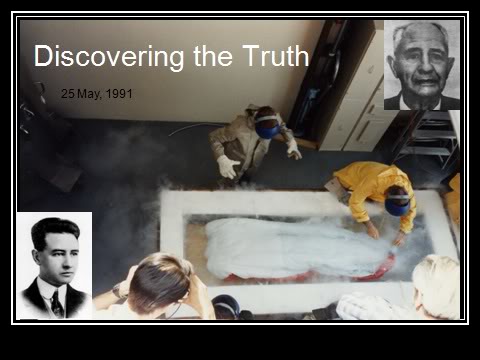
SLIDE 69
This afforded us an opportunity to examine him for the first time in 24 years. Now, you too will have the same opportunity.
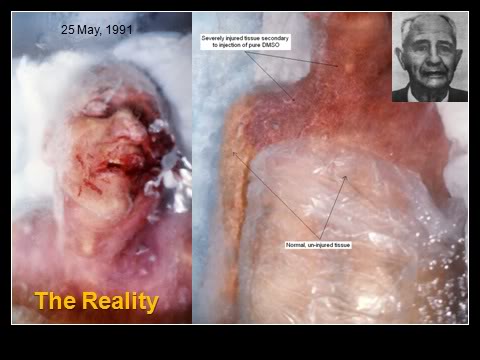
SLIDE 70
This is the reality of the “care” that Nelson gave Dr. Bedford. He was not perfused, but rather pin-cushioned with syringes of either neat, or highly concentrated DMSO. The large areas of scalded looking skin are probably a result of the hemolytic action of the DMSO solution which was being injected into the vicinity of the carotid arteries in the neck.
The frozen bloody exudate from his mouth and nose is a result of incompetently performed manual chest compressions administered in an attempt to ‗circulate‘ the DMSO to his brain and other vital organs.
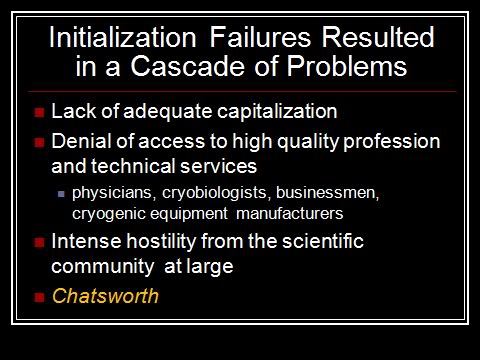
SLIDE 71
This deceit and evasiveness alienated competent individuals and caused a cascade of problems that made the environment for cryonics more hostile. This in turn contributed to the lack of adequate capitalization and denial of access to high quality profession and technical services such as physicians, cryobiologists, businessmen and cryogenic equipment manufacturers.
It also provoked intense hostility from the scientific community at large and last, but by no means least, it resulted in Chatsworth. Nelson‘s lies hadn’t stopped with Bedford and they would not end until cryonics was nearly destroyed by his misconduct at Chatsworth where 9 people were found to have been allowed to thaw out (or in some cases had never been
frozen at all) and decompose under shocking conditions. Chatsworth resulted in a nearly decade long hiatus in progress in cryonics and the number of people cryopreserved dwindled to less than 1 per year during the interval of 1975 to 1987!
ABSENCE OF PREPARATION AND PLANNING
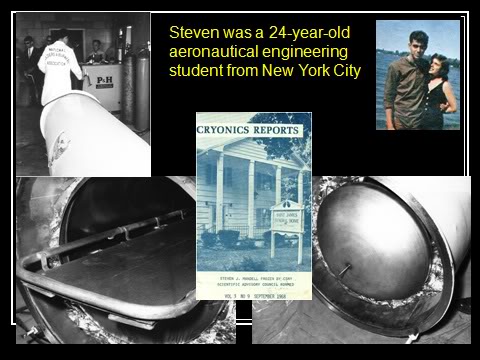
SLIDE 72
While fraud and deceit drove the failure of cryonics on the West Coast of the US, other factors were in play on the East Coast. In contrast to CSC, CSNY was operated in an open, above board and honest manner. While CSC‘s patients were decomposing at Chatsworth, CSNY‘s patients were relatively well cared for. In a sense, cryonics existed as two parallel universes a continent apart. This had a polarizing effect, dividing the few cryonics adherents who existed at that time (both the committed and the less so) into opposing camps; each suspicious of and unable to cooperate with the other.

SLIDE 73
On the East Coast, CSNY was making mistakes that would also prove damaging and eventually lethal. While fraud was not an element in these errors, lack of planning and foresight certainly contributed mightily. CSNY and its brother organization Cryo-Span, Inc. had no business plan, no protocols or procedures for delivering the technical aspects of care, and no emergency communication or response system. As CSNY‘s
President, Curtis Henderson was later to say, “We were just making it up as we went along.” On 28 July, 1968 CSNY cryopreserved its first member, Steven J. Mandel.
In the slides that follow I want to give you some visual images that will hopefully provide you with a feeling for what cryonics was like at that time, both in terms of its technology and in terms of its public image.
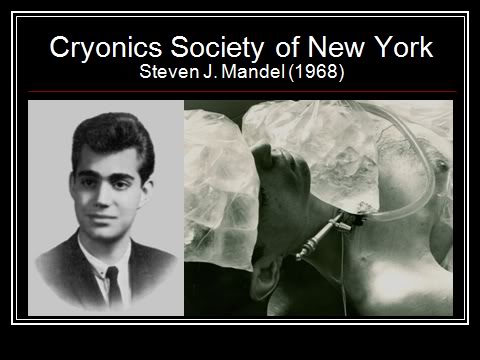
SLIDE 74
Steven was a 24-year-old aeronautical engineering student from New York City who was already gravely ill when he made arrangements with CSNY and purchased his life insurance. In fact, he was uninsurable, and experienced legal death well
before the non-contestability period of the policy had elapsed. There was no money to pay for the immediate expenses of perfusing and freezing him, let alone to cover the cost of indefinite storage in liquid nitrogen. This situation became known to the management of CSNY within days of Steven‘s cryopreservation.

SLIDE 75
Despite the absence of funding, CSNY proceeded to place Steven into long term storage and rely upon promises from his mother, Pauline Mandel, to provide regular payments for his long term care.
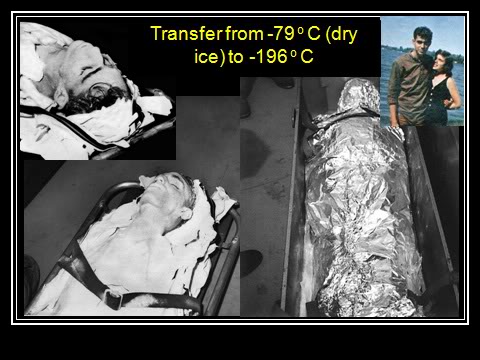
SLIDE 76
This decision was made for many reasons including lack of experience, naiveté, and a strong desire to ‗keep up with the Nelsons‘ and garner media attention which it was believed would further the program and attract additional members and customers.
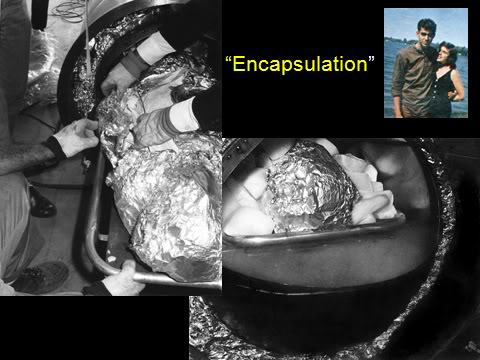
SLIDE 77
This decision depleted the organization of its capital equipment and cash and subjected it to the considerable expense in time and money of operating a storage facility for whole body patients. While in some ways this was beneficial in that it ‗forced‘ these facilities into existence and also forced the principals of CSNY to confront the logistic, technical and business realities of actually delivering human cryopreservation services, it did not provide them with either the capital or human resources to do these things effectively.
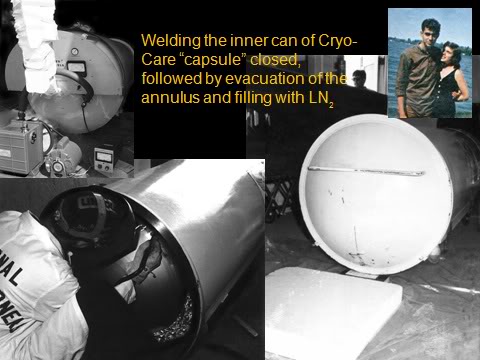
SLIDE 78
Unlike Nelson, who was able to show impressive drawings of his non-existent facility, CSNY had to be content with exposing its modest, indeed crude appearing operation to public scrutiny. The rough nature of the operation, housed as it was in the groundskeepers‘ room of a Long Island cemetery did not inspire confidence in the public or in CSNY’s own members.
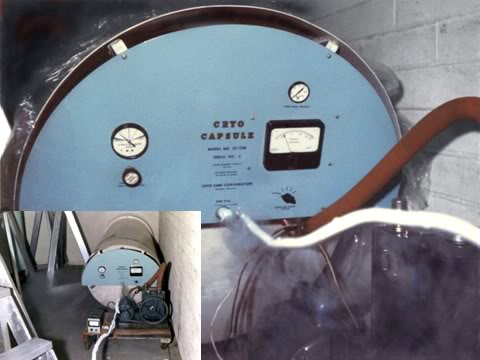
SLIDE 79
Despite, and in large measure because of these difficult experiences, Curtis Henderson became focused on developing reliable cryogenic storage equipment, and one beneficial outcome of CSNY‘s efforts was the creation of the first reliable and cost-effective equipment for human cryogenic storage, the Minnesota Valley Engineering dual patient upright, Superinsulated™ high vacuum dewar.
The previous horizontal units manufactured by Cryo-Care Corporation of Phoenix, AZ were notoriously unreliable and very inefficient making long term care cost-prohibitive.
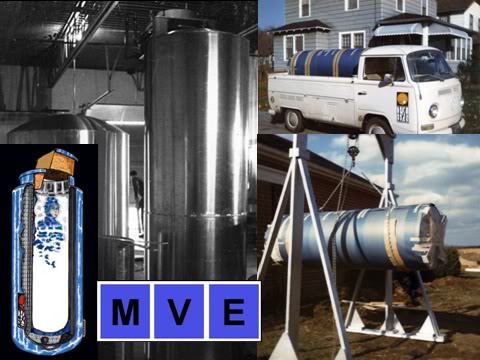
SLIDE 80
Because the patients accepted by CSNY were all third-party cases – situations where the relatives had either initiated cryopreservation or were expected to pay for it, decisions about how patient‘s were cared for became disconnected from rational, scientific or even simple and straightforward technical requirements. The relationship of the cryonics organization was not with the patient, but rather with his next-of-kin.
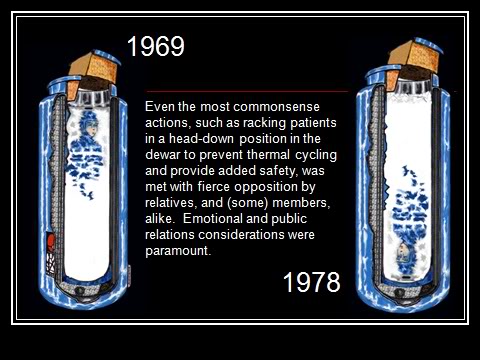
SLIDE 81
When the MVE dewars were first put into service in August of 1969, it was argued that for commonsense reasons of safety, patients should be racked in the dewar in a head down position. In the early 1970s I argued strenuously that in addition to providing extra protection in the event of vacuum failure, racking patients in a head-down position in the dewar would prevent the enormous thermal cycling that the head and brain were experiencing each time the unit was topped up with liquid nitrogen (i.e., quench cooling of the head from ~ -145oC to -196oC in a matter of minutes).
This proposal was met with fierce opposition by relatives, and (some) CSNY members, alike. Emotional and public relations considerations were paramount. I was told, “We can‘t have our patients in there upside down standing on their heads! People will really think we are crazy!” If you look carefully at the photo of the patient at the upper left of this slide, you can see a line demarking the liquid nitrogen level. Because liquid nitrogen is dispensed in 160 liter containers the liquid level after filling had to be allowed to fall to approximately mid-chest level, exposing the upper body to a continuous series of cycles of cooling and warming with a delta T of ~50oC.
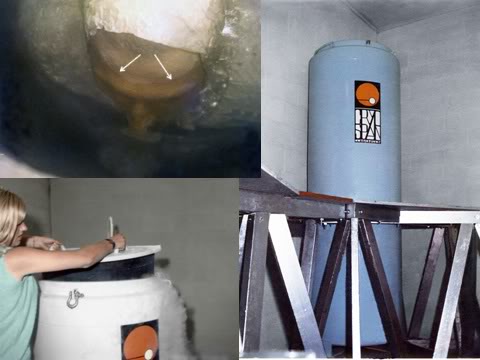
SLIDE 82
The third party problem was greatly exacerbated when CSNY cryopreserved Ann DeBlasio in January of 1969. Mrs. DeBlasio was the wife of a blustering and contentious New York City police officer who often ended discussions by waving his firearm menacingly.
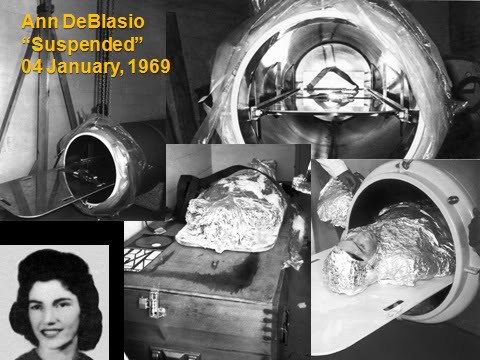
SLIDE 83
DeBlasio, seen looking in through the doorway as his wife‘s dewar is consecrated by the family priest, Rev. Severio Mattei, had no idea of what cryonics was really like.
Understandably, he expected a professional operation with a solid technical basis and, at least, a reasonable aesthetic front. What he was confronted with were a group of people who defied convention in almost every way and a primitive facility that could not even be locked and where groundskeepers tossed their cigarette butts onto the floor and left the waste from their lunches on his wife‘s temporary storage container.
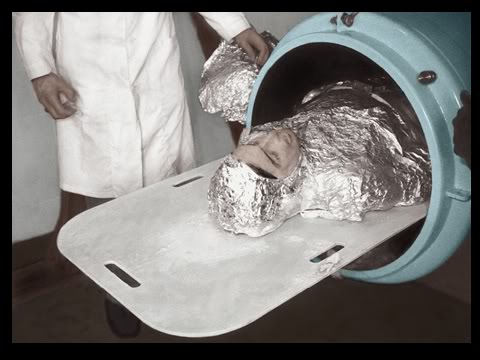
SLIDE 84
So, while Ann DeBlasio became CSNY‘s second patient in long term storage, the situation was not stable and there was dissatisfaction and unhappiness on all sides.
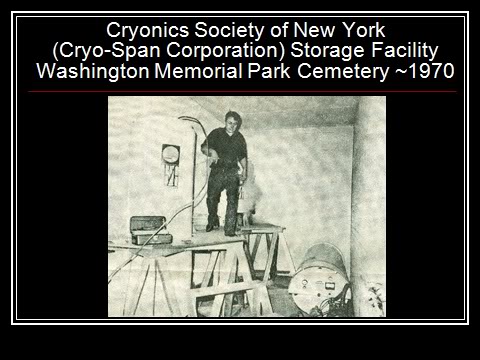
SLIDE 85
This cramped, crude CSNY facility, coupled with a lack of professionalism and the absence of a business-like approach crippled, and arguably destroyed CSNY – and did much to injury cryonics as a whole.
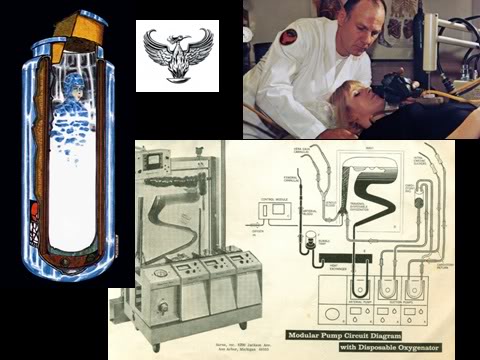
SLIDE 86
While the men who ran CSNY were honest and made no attempt to hide their shortcomings, they nevertheless projected, through their publications and literature, an image of competence and skill that was wholly lacking. In fairness, they understood much of what needed to be done, but having committed themselves to the formidable and unrelenting task of actually delivering cryogenic care (in the absence of adequate resources) it became virtually impossible for them to pursue the proper course of action.
End of Initialization Failure, Part 3
